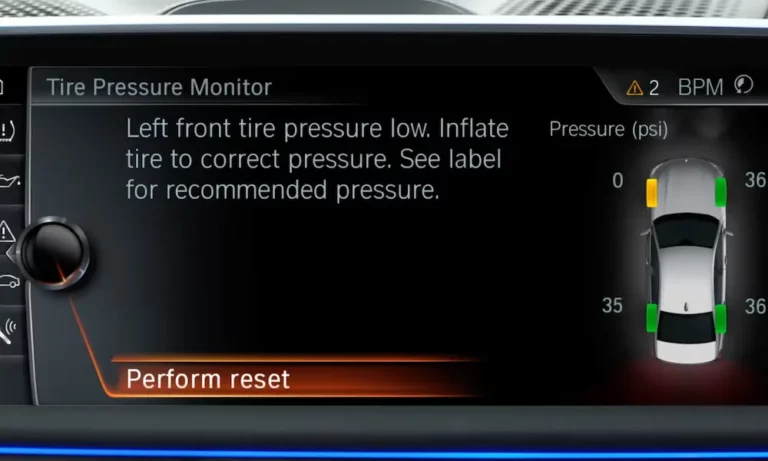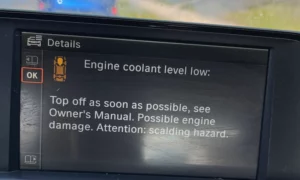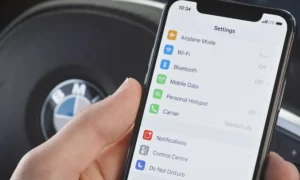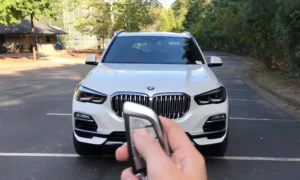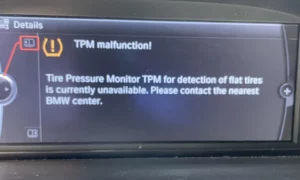Have you noticed that annoying yellow tire pressure warning light on your BMW’s dashboard? It’s something many BMW owners face, but don’t worry—resetting your BMW tire pressure monitoring system is simpler than you might think.
What Is the BMW Tire Pressure Monitoring System?
BMW’s tire pressure monitoring system (TPMS) constantly checks your tire pressure while driving. It uses sensors to detect when pressure drops below the recommended level, triggering that yellow warning light on your dashboard.
The system works by establishing baseline pressure values. When you reset it, you’re essentially telling your BMW, “These are the correct pressure levels—use them as your new reference point.” This is why a BMW tire pressure reset is necessary after:
- Inflating previously low tires
- Replacing one or more tires
- Switching between summer and winter tires
- When the warning persists despite proper inflation
How to Reset BMW Tire Pressure on iDrive 7 or Newer Models
Modern BMWs with iDrive 7, 8, or 9 systems make the reset process straightforward through the central display screen. Here’s how to do it:
- Make sure your engine is running
- From the home screen, select the car icon using either the iDrive Controller or touchscreen
- Select “Vehicle Status”
- Tap “Tire Pressure Monitor”
- Select “Tire Settings”
- Tap “Perform Reset”
- Drive for a few minutes to complete the calibration
This process works for most newer BMW models including the 3 Series, 5 Series, X3, X5, and others equipped with the latest iDrive systems.
What If There’s No “Perform Reset” Option?
Some of the newest BMW models have a slightly different menu structure. If you don’t see a “Perform Reset” option:
- Navigate to the Check Control screen
- Click “Tire pressure menu”
- Tap “Tire Settings”
- Verify your tire type and specifications
- Click “Save tire settings” (this functions as the reset)
- Drive until the TPM reaches 100% calibration
Your car needs to establish new baseline readings while in motion, so don’t be surprised if the reset isn’t immediate. Typically, a short drive of about 5-10 minutes is enough for the system to complete its calibration.
Resetting BMW Tire Pressure on Older Models (E90 Series and Similar)
If you drive an older BMW model (like E90, E92, E60 series), the reset process uses the turn signal stalk instead of the iDrive system:
- Turn your ignition to position 2 (when dashboard lights illuminate but engine isn’t started)
- Press the button at the end of the turn signal stalk up twice
- Press and hold the button for approximately 5 seconds
- Wait until you see a confirmation (usually an arrow disappears or the tire pressure light briefly flashes)
The process is quick but may vary slightly depending on your exact model year. If you’re unsure which generation of BMW you have, check your owner’s manual for the specific reset procedure.
How to Set Different Tire Types for Season Changes
One of the clever features of BMW’s tire pressure system is its ability to store settings for different tire sets. This is particularly useful when switching between summer and winter tires:
- Follow steps 1-3 from the standard reset procedure
- Select “Tire Settings”
- Tap “Tire Selection”
- Choose the appropriate tire type (Summer or Winter/All-Season)
- Select your tire size
- Choose the speed rating (typically above or below 100 mph)
- Save your settings
This feature ensures your TPMS works correctly regardless of which seasonal tires you’re using.
BMW Tire Pressure Reset: Essential Tips for Success
For a successful BMW tire pressure reset, keep these important points in mind:
- Your car must be stationary with the engine running when initiating the reset
- You must drive the vehicle after resetting (typically 5-10 minutes) for the system to complete calibration
- In colder weather, tire pressure naturally decreases. Consider setting pressure 2-3 PSI above the recommended level to prevent frequent warnings during winter
- If the reset process fails, try changing the tire type setting to something else and back again—this can trigger a system rescan
| Common BMW TPMS Issues | Potential Solutions |
|---|---|
| Warning light returns shortly after reset | Check for slow leaks or valve stem issues |
| System won’t complete calibration | Drive at various speeds (25-50 mph) for 10+ minutes |
| Reset option missing from menu | Check if your model uses physical button reset instead |
| TPMS warning persists despite proper inflation | Sensors may need replacement (5-10 year battery life) |
Troubleshooting Persistent BMW Tire Pressure Warning Lights
If your BMW’s tire pressure warning light keeps returning after a reset, work through these troubleshooting steps:
- Verify all tires are properly inflated to the pressure listed on your driver’s door jamb sticker
- Ensure you’ve completed the necessary drive cycle after reset
- Check for visible damage to tires or valve stems
- Consider the age of your TPMS sensors—they contain batteries with 5-10 year lifespans
- For specific error messages like “Tire Pressure Monitor Malfunction,” consult your BMW dealer as sensor replacement may be necessary
Remember that extreme temperature changes can trigger false warnings. A 10°F drop in temperature can decrease tire pressure by 1-2 PSI, potentially triggering the system.
Best Practices for BMW Tire Pressure Maintenance
To minimize TPMS warnings and maximize tire life, follow these best practices:
- Check tire pressure monthly with a quality gauge (preferably when tires are cold)
- Follow BMW’s recommended pressure levels (found on the driver’s door jamb)
- Inspect tires regularly for damage, uneven wear, or embedded objects
- Remember that proper tire pressure improves fuel economy and handling
- Consider seasonal pressure adjustments—slightly higher in winter, as recommended by safety experts
The BMW tire pressure monitoring system is designed to enhance your safety by alerting you to potentially dangerous pressure issues. By understanding how to properly reset it, you’ll avoid unnecessary warning lights and ensure your tires are always operating at their optimal pressure.
Maintaining proper tire pressure isn’t just about avoiding warning lights—it’s about safety, performance, and extending the life of your expensive BMW tires. With these simple reset procedures, you can keep your BMW running smoothly and safely all year round.

